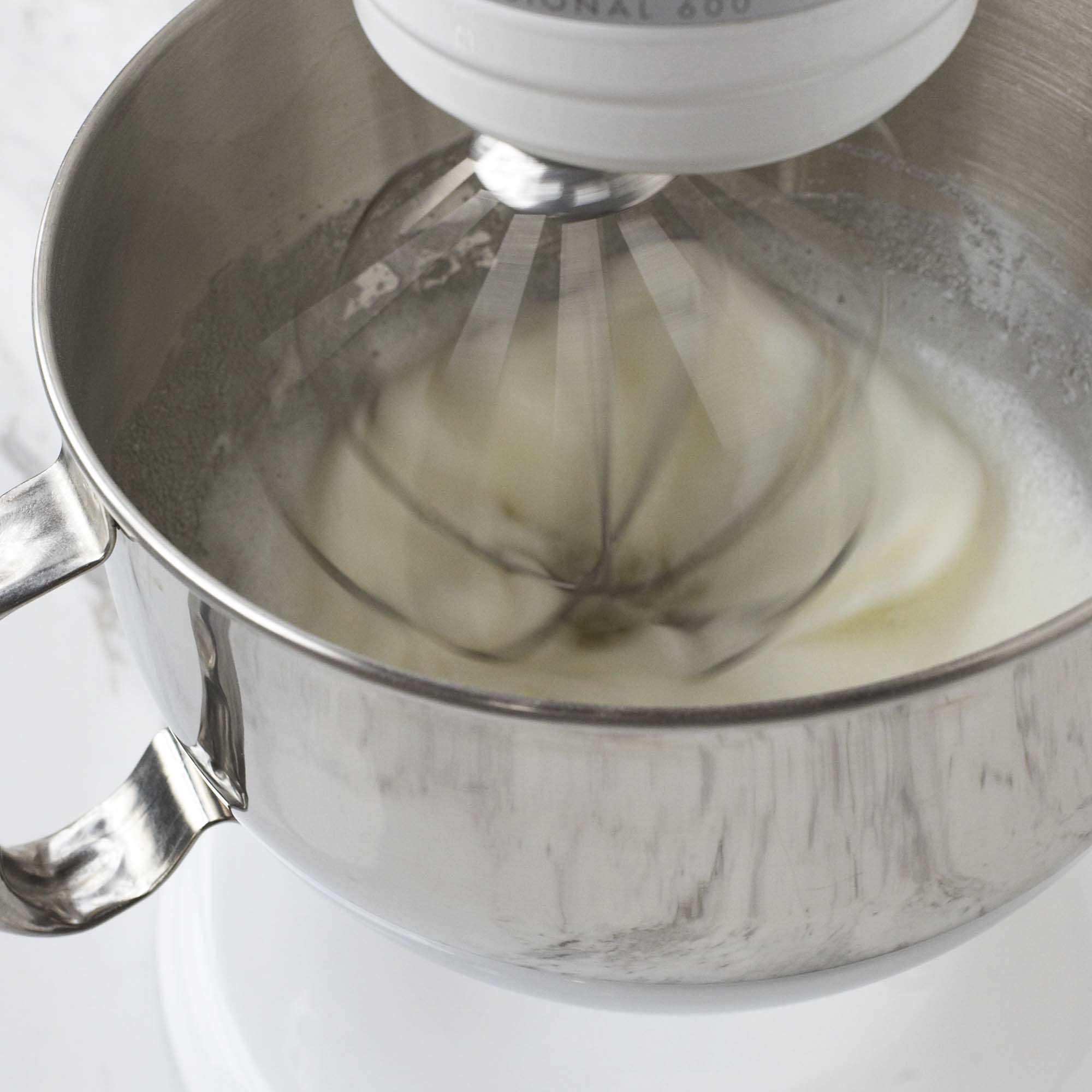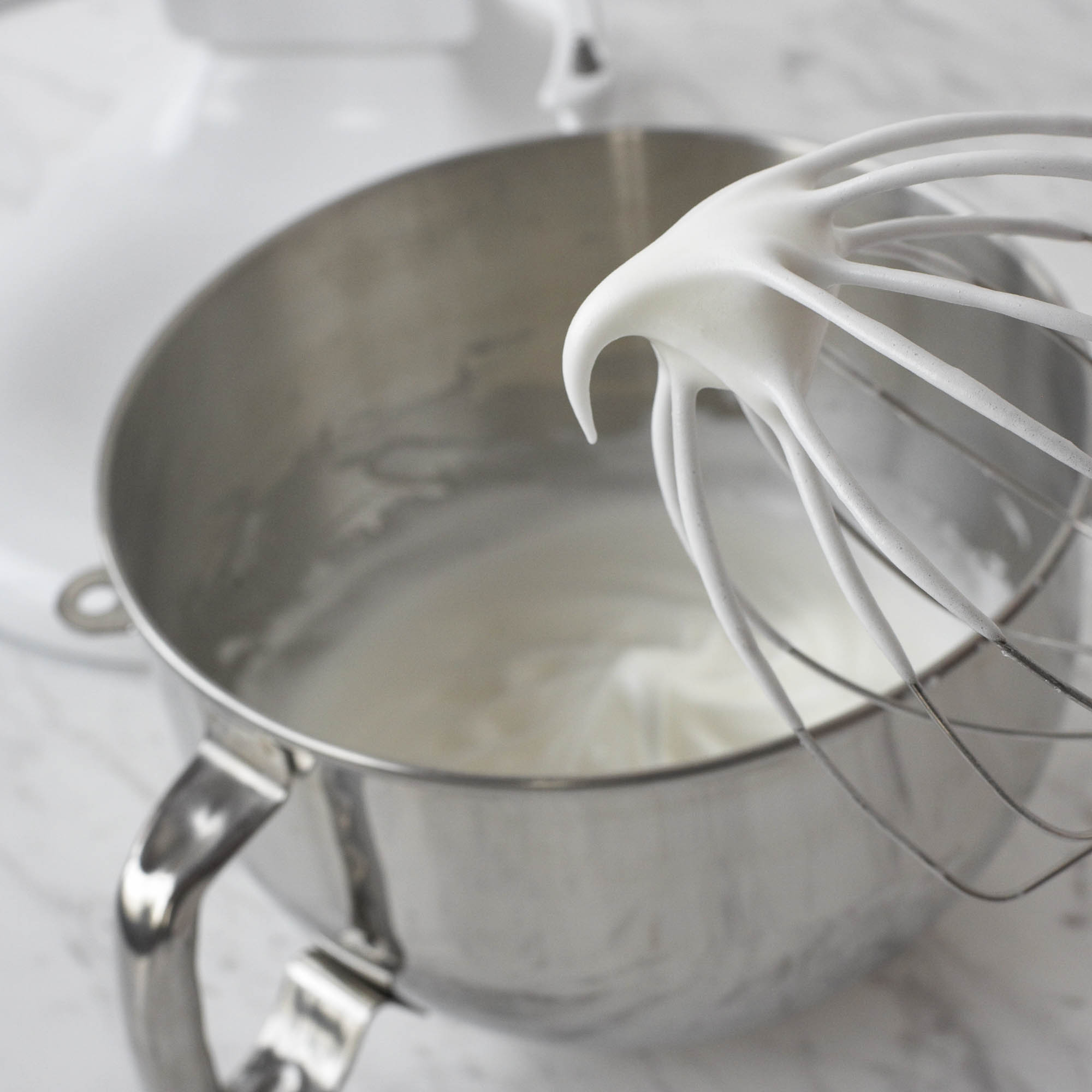Follow the steps and tips of how to make a hard meringue. You’ll be surprised at how easy they are to make!
Ingredients and Directions
Directions

BEAT egg whites and cream of tartar in mixer bowl with whisk attachment on high speed until foamy.

Beating constantly, ADD sugar, 2 Tbsp. at a time, beating after each addition until sugar is dissolved before adding the next. (Rub a bit of meringue between thumb and forefinger; it should feel completely smooth.) Continue beating until whites are glossy and stand in stiff peaks. BEAT IN vanilla.
Ingredients
- EGG WHITES, room temperature 3
- tsp. cream of tartar 1/4
- cup sugar 3/4
- tsp. vanilla 1/2
Enjoy
This easy meringue recipe demonstrates the ingredients, proportions and techniques you’ll need to make basic hard meringue, a component of many popular desserts. Hard meringue is also known as Swiss Meringue.
Use it to make meringue pie shell for angel pies, such as Key Lime Angel Pie, or to make individual tartlet shells for meringue glacés filled with ice cream.
Popular confections such as Meringue Kisses and meringue mushrooms are made from hard meringue.
Baked in round, square or rectangular layers and stacked with creamy fillings and cake layers, hard meringue is part of many elegant desserts, such as Pavlova, Schaum torte and dacquoise.
Basic hard meringue can be flavored with cocoa powder, instant espresso powder, extracts or ground spices. Ground nuts such as almonds and pecans are often added.
Insider Tips on How to Make a Perfect Hard Meringue
Choose a dry day. Humidity is a critical factor in making hard meringue. Because sugar is hygroscopic (moisture-absorbing), hard meringues made on a humid day can become limp and sticky.
Bowl size (and shape) matters. For proper aeration, a small mixer bowl is best for up to 3 egg whites; a large mixer bowl for 4 or more egg whites. When beaten, egg whites increase as much as 6 to 8 times in volume. The bowl should be large enough to hold the expanding whites, but not so large that the whites are spread too thin. The bowl should be deep enough for the beaters to make contact with as much of the whites as possible.
Keep the yolks separate from the whites. Fat from egg yolk will prevent egg whites from beating up properly. When separating eggs, take care that no yolk gets in the whites. To avoid an accident, separate each egg white into a cup or small bowl before transferring it to the mixer bowl. Discard any white that has even a speck of yolk in it.
Equipment: Beaters and bowl should be spotlessly clean. Any residue of fat will prevent egg whites from beating up properly. Use a stainless steel or glass bowl. Plastic bowls can retain a film of grease.
Egg temperature: It’s easiest to separate eggs cleanly when they are refrigerator cold. However egg whites whip up to greater volume when they’ve had a chance to warm up a bit, 20 to 30 minutes. Always begin by separating the eggs. Let the whites stand at room temperature while you prepare the baking pan, equipment and other ingredients.
Cream of tartar: The air beaten into egg whites can be lost quite easily. A small amount of acidic ingredient, such as cream of tartar, acts as a stabilizing agent. A bit of lemon juice or vinegar will also work.
Salt decreases egg-white foam stability, so it is not used in hard meringues.
Add sugar gradually. For optimum volume and smoothest texture, sugar should be added gradually, beginning only after the whites have been beaten to the foamy stage (about double in volume). Adding some or all of the sugar before beginning to beat will result in less volume.
To check if sugar is dissolved: After each addition, whites should be beaten until the sugar has dissolved before adding more. To test, rub a bit of meringue between thumb and forefinger. If sugar is dissolved, it will feel completely smooth. If it feels grainy or sandy, continue beating. Undissolved sugar can cause sugar spots on the hard meringue surface.
What’s a stiff peak? Hard meringue should be beaten until it appears glossy and stands in tall peaks that do not curl at the tips when the beater or whisk is lifted.
Sugars: Hard meringue is made with a ratio of 4 Tbsp. sugar per egg white. It can be made with any sugar. One cup of superfine sugar or packed brown sugar is equal to 1 cup of granulated sugar; 1-3/4 cups powdered sugar equals 1 cup granulated. Superfine sugar may dissolve more readily and produce a smoother glossier meringue, but volume will not be as great. Powdered sugar contains cornstarch, which may produce a drier meringue.
Mixers: Using an electric portable or stand mixer on high speed is easiest. Hard meringue can be beaten with rotary beater or balloon whisk, but requires more than average arm strength and endurance.
Shaping: Pipe meringue through a pastry bag for fanciful shapes or fluted edges, or simply spread and shape it with the back of a spoon or a spatula.
Prepare the surface. Baking sheets and pans, even those with nonstick surfaces, should be lined with parchment paper or aluminum foil or lightly greased and floured. Hard meringues are less likely to stick on lined equipment.
Baking is a misnomer. Hard meringues are not actually baked, but are dried in a 225°F oven for 1 to 1-1/2 hours. They are left in the oven after it is turned off to continue drying without browning.
Chewier texture: If you prefer a chewy marshmallow-like center, reduce baking time. After 45 to 55 minutes, begin testing the texture by inserting a wooden pick into the side of the meringue. When baked to your liking, check with an instant-read thermometer to see that the internal temperature has reached 160°F. Turn oven off and let meringue cool with the door closed.
Lightly browned: If you prefer meringue with some color, increase the oven temperature to 250°F and bake for 50 minutes or until color is delicately browned and wooden pick inserted in center comes out clean. When baked to your liking, check with an instant-read thermometer to see that the internal temperature has reached 160°F. Turn oven off and let hard meringue cool with the door closed.
To store: Place baked hard meringue in tightly sealed container, with waxed paper between layers. To re-crisp: If stored hard meringues lose their crispness, bake in 200°F oven 15 to 20 minutes.
